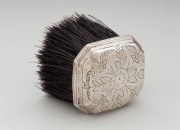Difference between revisions of "Bristle"
m (Text replace - "== Authority ==" to "== Sources Checked for Data in Record ==") |
|||
| Line 1: | Line 1: | ||
| − | [[File:2002.27.9-SC40260.jpg|thumb|]] | + | [[File:2002.27.9-SC40260.jpg|thumb|Brush in toilet set<br>MFA# 2002.27]] |
== Description == | == Description == | ||
| Line 10: | Line 10: | ||
brush | brush | ||
| − | == | + | ==Physical and Chemical Properties== |
Lengths up to 13 inches. Bristles have a natural curve and springiness. They often have flags (split ends at tips) | Lengths up to 13 inches. Bristles have a natural curve and springiness. They often have flags (split ends at tips) | ||
| − | == | + | ==Resources and Citations== |
* J.Gordon Cook, ''Handbook of Textile Fibres:I Natural Fibres'', Merrow Publishing Co. , Durham, England, 1984 | * J.Gordon Cook, ''Handbook of Textile Fibres:I Natural Fibres'', Merrow Publishing Co. , Durham, England, 1984 | ||
| − | * ''Encyclopedia Britannica'', http://www.britannica.com Comment: "brush" | + | * ''Encyclopedia Britannica'', http://www.britannica.com Comment: "brush" [Accessed October 16, 2003]. |
* Edward Reich, Carlton J. Siegler, ''Consumer Goods: How to Know and Use Them'', American Book Company, New York City, 1937 | * Edward Reich, Carlton J. Siegler, ''Consumer Goods: How to Know and Use Them'', American Book Company, New York City, 1937 | ||
Latest revision as of 10:17, 10 May 2022
Description
A stiff hair or fiber used for brushes. Natural bristles are obtained from the back or shoulders of swine (hogs, pigs, or boars). They can be white, yellow, bronze, gray, or black. From the 16th century to 1917, Russia was the major exporter of brush bristles (usually white). China began exporting natural black bristles in 1889 to the U.S. and these quickly gained in popularity. Currently most natural hair bristles come from India. A flag, or split end, adds to the paint carrying ability of the bristle. Some plant fibers, such as piassava, are also used for brush bristles. Synthetic bristles are various stiff monofilament fibers such as nylon, and polyethylene.
Synonyms and Related Terms
brush
Physical and Chemical Properties
Lengths up to 13 inches. Bristles have a natural curve and springiness. They often have flags (split ends at tips)
Resources and Citations
- J.Gordon Cook, Handbook of Textile Fibres:I Natural Fibres, Merrow Publishing Co. , Durham, England, 1984
- Encyclopedia Britannica, http://www.britannica.com Comment: "brush" [Accessed October 16, 2003].
- Edward Reich, Carlton J. Siegler, Consumer Goods: How to Know and Use Them, American Book Company, New York City, 1937
- F. Kidd, Brushmaking Materials, Bristish Brush Manufacturers, London, 1957
- Zora Sweet Pinney, 'A Handle on the Terms used for Artists' Brushes', unpublished glossary, 1999
- G.S.Brady, Materials Handbook, McGraw-Hill Book Co., New York, 1971
- Random House, Webster's Encyclopedic Unabridged Dictionary of the English Language, Grammercy Book, New York, 1997
- The American Heritage Dictionary or Encarta, via Microsoft Bookshelf 98, Microsoft Corp., 1998

